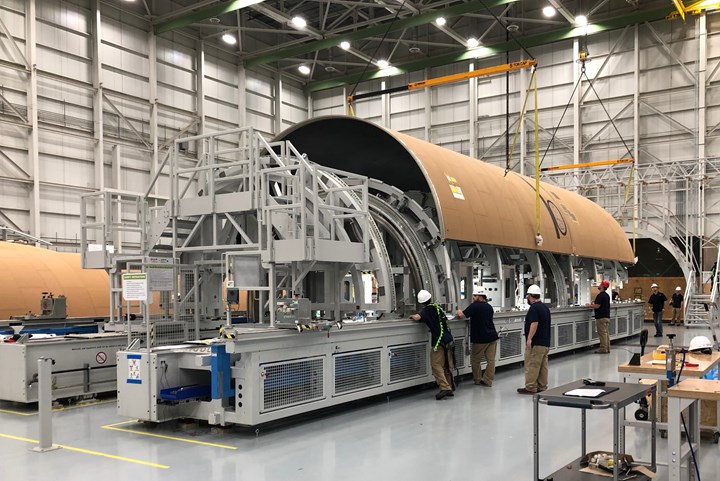To boldly go . . .
Space travel is a challenge, even if filmmakers like to make us think otherwise.

Manufacture of spacecraft payload fairings at RUAG Space (Bern, Switzerland; renamed to Beyond Gravity) in Decatur, Ala., U.S., from CW senior editor Scott Francis’s recent plant tour. CW Photo | Scott Francis
I was just nine years old in 1977 when the first movie from the Star Wars franchise was released. I was 52 in 2019 when the 11th and final movie was released. By virtue of its longevity and sheer quantity of films, Star Wars has become the de facto source of our understanding of traveling through and living in space, augmented by other notable space-based films and television series, including 2001: A Space Odyssey, Star Trek, the Alien series, Interstellar, The Martian, Gravity, Battlestar Galactica (classic and reboot) and, more recently, First Man and The Expanse.
One of the things that has enabled all of these depictions, and has helped draw audiences to them, is the special effects made possible by rapidly advancing computer technology. I remember, in 1977, watching Star Wars for the first time, and feeling like a whole new reality was unfolding before me, replete with hovercraft, speed-of-light space travel, laser weapons and tractor beams.
I also remember, in 1977, not worrying one bit about how the world depicted in Star Wars violated innumerable laws of physics — particularly those governing space travel. Star Wars, and many of the films and shows that followed, took great liberties depicting momentum, gravity, radiation, pressure and temperature in ways designed primarily to drive plot and action. I also think many of us are willing to suspend our disbelief regarding the physics of space travel in exchange for an entertaining story.
Perhaps the most realistic — and harrowing — movie about space travel was 1995’s Apollo 13, which was the true story of the third NASA mission, in 1970, intended to land American astronauts on the moon. Two days into the mission, the oxygen tank in Apollo 13’s service module failed, and the mission was aborted. The astronauts were forced to find a way to get back to Earth with limited oxygen supply. What made the Apollo 13 film so compelling was its realism — because it was based on actual events, the movie’s makers were forced to depict realistically the daunting physical challenge of the mission such as dwindling air supply, limited power, cold and wet cabin conditions and more. As faithful as this treatment was, however, it is the exception to the rule.
A result of this, I fear, is that many of us underestimate just how difficult it is to get people aboard a spacecraft into space and safely to their destination. First, you have to overcome Earth’s gravity and the air resistance of its atmosphere. After that, you face the task of directing the craft toward its target — the International Space Station (ISS), the moon, Mars, etc. Today it costs about $1,000 to deliver 1 kilogram into low-Earth orbit (99 to 1,200 miles altitude), and a whole lot more to travel further.
Consider, for instance, that since the Space Shuttle program ended in 2011, the United States has not had a vehicle with which to take astronauts to the ISS. We hope to change this soon. Boeing and SpaceX are each working on spacecraft that will ferry astronauts to and from ISS. Boeing’s is called Starliner; SpaceX calls its craft Crew Dragon. These craft have been years in the making, and both have had successes and failures emblematic of the trial and error associated with space development programs. Both also hope to deliver humans to ISS within the year.
Of course, the ultimate goal is to travel to the moon and eventually Mars, and doing so will require smart use of composites. One company in the thick of this effort is RUAG Space, which is working on out-of-autoclave fabrication of massive carbon fiber composite structures for the Atlas and Vulcan launch vehicles and is a supplier to Boeing’s Starliner program. RUAG Space was kind enough to open the doors of its Decatur, Ala., U.S., plant to CW senior editor Scott Francis.
If we do eventually put humans on Mars, the effort most assuredly will be governed by the laws of physics, which means it will be expensive, challenging and rewarding. And it will, no doubt, also be a movie.
Related Content
Ultrasonic welding for in-space manufacturing of CFRTP
Agile Ultrasonics and NASA trial robotic-compatible carbon fiber-reinforced thermoplastic ultrasonic welding technology for space structures.
Read MoreNear-zero erosion ultra-high temperature CMC
K3RX commercializes UHTCMC for a wide range of markets, demonstrating performance in prototypes, assemblies and advancing manufacturing to reduce cost.
Read MoreCarbon fiber satellite arm reduces weight, simplifies assembly onto naval vessels
Satcom developer EM Solutions partnered with ACS Australia to replace an aluminum arm design with a 65% lighter, one-piece, corrosion-resistant carbon fiber/epoxy alternative.
Read MoreNew GTL breakthrough in composite tubing for liquid hydrogen in aircraft and space vehicles
Tests versus stainless steel tubing show 10 times faster chill down, fuel flow in 2 seconds and less boil-off for significantly faster fueling and refueling of LH2-powered space vehicles, aircraft and trucks.
Read MoreRead Next
Next-gen fan blades: Hybrid twin RTM, printed sensors, laser shock disassembly
MORPHO project demonstrates blade with 20% faster RTM cure cycle, uses AI-based monitoring for improved maintenance/life cycle management and proves laser shock disassembly for recycling.
Read MoreScaling up, optimizing the flax fiber composite camper
Greenlander’s Sherpa RV cab, which is largely constructed from flax fiber/bio-epoxy sandwich panels, nears commercial production readiness and next-generation scale-up.
Read MoreCutting 100 pounds, certification time for the X-59 nose cone
Swift Engineering used HyperX software to remove 100 pounds from 38-foot graphite/epoxy cored nose cone for X-59 supersonic aircraft.
Read More












